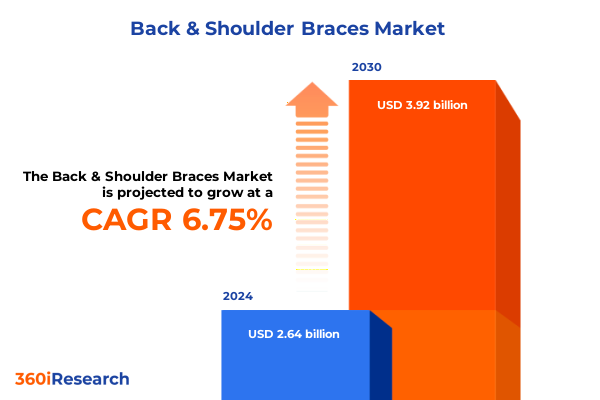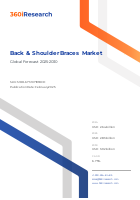The Back & Shoulder Braces Market size was estimated at USD 2.64 billion in 2024 and expected to reach USD 2.83 billion in 2025, at a CAGR 6.75% to reach USD 3.92 billion by 2030.

Introduction to the Back & Shoulder Braces Market
The back and shoulder braces market is experiencing robust growth driven by increasing prevalence of musculoskeletal disorders, rising awareness of preventive healthcare, and technological innovations that enhance patient comfort and therapeutic outcomes. Aging populations in developed nations face heightened incidence of chronic back pain and postural dysfunction, prompting demand for both corrective and supportive devices. Concurrently, sports medicine professionals and fitness enthusiasts seek advanced braces to optimize performance and prevent injuries during high-intensity activities. Regulatory bodies are streamlining approvals for medical devices, facilitating faster market entry of next-generation products. Meanwhile, the proliferation of e-commerce channels has expanded access to a broader consumer base, allowing direct-to-consumer brands to challenge traditional retail models. Tenant to all these dynamics is a growing emphasis on customized solutions-from 3D-printed lumbar supports to sensor-equipped posture controllers-that cater to individual anatomical and therapeutic requirements. This introduction sets the stage by outlining core market drivers and emerging trends that stakeholders must navigate to harness the full potential of back and shoulder brace innovations.
Transformative Shifts Redefining Industry Dynamics
The industry landscape has undergone transformative shifts that redefine competitive dynamics and customer expectations. Sensor integration and real-time monitoring now enable smart braces to deliver personalized feedback on posture, movement analytics, and rehabilitation progress. Material science advancements, such as temperature-regulating fabrics and anti-bacterial treatments, are elevating comfort and hygiene, expanding use cases from post-surgery recovery to prolonged workplace wear. Digital health platforms and telemedicine services have created new channels for remote fitting and virtual consultations, reducing the need for in-person visits. Simultaneously, original equipment manufacturers and startups are leveraging additive manufacturing to accelerate prototyping and introduce bespoke brace geometries. Distribution is also evolving: direct-to-consumer e-commerce platforms complement traditional hospital pharmacy and physiotherapy center outlets, while subscription models for brace upgrades and maintenance foster ongoing patient engagement. Amid these shifts, sustainability has emerged as a strategic priority, with biodegradable materials and carbon-neutral production processes gaining traction. Together, these transformative developments are reshaping product portfolios, supply chains, and go-to-market strategies across the sector.
Cumulative Impact of United States Tariffs in 2025
The implementation of new tariff measures by the United States in 2025 has exerted significant pressure on global supply chains, particularly for textile and metal components integral to brace manufacturing. Import duties on specialty fabrics and injection-molded polymer parts have driven up input costs, prompting manufacturers to absorb expenses or pass them on to end users. In response, several suppliers have accelerated efforts to near-shore production facilities or diversify sourcing across low-tariff regions, mitigating exposure to punitive duties. Domestic manufacturers have capitalized on this environment to expand capacity and form strategic partnerships with raw material providers, enhancing supply chain resilience. Moreover, procurement teams are negotiating long-term contracts to lock in favorable pricing and ensure steady inventory flow. While end-user prices have adjusted upward in certain segments, the focus on value-added features such as magnetic therapy inserts and semi-rigid support structures has helped justify cost differentials. Overall, the cumulative impact of tariffs has catalyzed innovation in sourcing strategies and reinforced the importance of agile manufacturing footprints.
Key Segmentation Insights Driving Market Tailoring
In-depth segmentation analysis reveals the nuanced ways manufacturers and distributors tailor offerings to distinct customer needs. Based on product type, the market comprises compression braces designed in elastic fabric or enhanced with magnetic therapy, lumbar support units, orthopedic braces in rigid or semi-rigid configurations, posture braces, scoliosis braces, and shoulder braces that provide clavicle support or target rotator cuff stabilization. When examining applications, chronic pain relief solutions coexist alongside devices for injury rehabilitation, post-surgery recovery, postural correction, and sports & fitness performance enhancement. Material type segmentation highlights choices among blended fabric, cotton, elastic, foam, and neoprene, each selected for its unique combination of durability, comfort, and moisture management. Distribution channels range from offline retail environments-hospital pharmacies, physiotherapy centers, specialty stores-to online retail through dedicated brand websites and major e-commerce platforms. Age group distinctions separate adults, children, and senior citizens, ensuring proper fit and support across life stages. End-user categories include clinics, home care scenarios, hospitals, and sports rehabilitation centers, while user gender segmentation addresses anatomical differences among female and male wearers. Finally, technology features such as adjustable straps, anti-bacterial properties, breathable fabric, and temperature regulation enable manufacturers to differentiate products and deliver targeted therapeutic benefits.
This comprehensive research report categorizes the Back & Shoulder Braces market into clearly defined segments, providing a detailed analysis of emerging trends and precise revenue forecasts to support strategic decision-making.
- Product Type
- Application
- Material Type
- Distribution Channel
- Age Group
- End-User
- User Gender
- Technology Feature
Regional Variations Shaping Growth Trajectories
Regional analysis underscores significant variations in market maturity, regulatory frameworks, and consumer preferences. In the Americas, the United States leads innovation with a robust medical device ecosystem and high reimbursement rates, while Canada and Mexico benefit from trade agreements that facilitate cross-border distribution. Europe, the Middle East & Africa present a heterogeneous landscape: Western Europe’s stringent quality standards and generous healthcare funding contrast with Middle Eastern markets that are rapidly expanding healthcare infrastructure, and African regions where affordability and basic access remain primary considerations. Asia-Pacific stands out for its dual dynamics of established markets such as Japan and Australia-characterized by advanced R&D and high consumer health awareness-and emerging economies like China and India, where urbanization, rising disposable incomes, and growing sports participation drive demand. E-commerce penetration across Asia-Pacific further accelerates reach into tier-2 and tier-3 cities, enabling global and local brands to secure a broader customer base.
This comprehensive research report examines key regions that drive the evolution of the Back & Shoulder Braces market, offering deep insights into regional trends, growth factors, and industry developments that are influencing market performance.
- Americas
- Asia-Pacific
- Europe, Middle East & Africa
Competitive Landscape with Leading Industry Players
The competitive landscape features a blend of multinational conglomerates, specialized orthopedic suppliers, and innovative startups. Leaders such as 3M Company and Bauerfeind USA Inc. leverage extensive R&D capabilities and global distribution networks to deliver premium orthopedic and compression solutions. Innovators like Alignmed and BraceAbility, Inc. focus on direct-to-consumer channels and customizable offerings. Aspen Medical Products, LLC and BackJoy Orthotics, LLC bring decades of clinical expertise to lumbar and posture support, while Bird & Cronin, LLC by Dynatronics Corporation and Dunbar Medical emphasize integration with physical therapy services. Dynamic Techno Medicals Pvt Ltd and ELove Technologies drive cost-effective manufacturing in emerging markets, complemented by Enovis, Inc and ERGODYNE by Klein Tools, which capitalize on industrial safety applications. GPC Medical Ltd. and Hugh Steeper Ltd by Eqwal Group serve orthopedic clinics across Europe. Iron Bull Strength and McDavid cater to athletic wearables, whereas Mueller Sports Medicine, Inc. and Neo G Limited focus on functional performance and recovery. OPPO Medical Inc and Orthomen emphasize pediatric and scoliosis solutions. Shock Doctor Inc., Sparthos, Tommie Copper, Inc., and Vive Health round out the field with performance-driven and wellness-oriented products. Across this diverse set of players, competition hinges on innovation in materials, sensor technology, and omnichannel distribution strategies.
This comprehensive research report delivers an in-depth overview of the principal market players in the Back & Shoulder Braces market, evaluating their market share, strategic initiatives, and competitive positioning to illuminate the factors shaping the competitive landscape.
- 3M Company
- Alignmed
- Aspen Medical Products, LLC.
- BackJoy Orthotics, LLC
- Bauerfeind USA Inc
- Bird & Cronin, LLC by Dynatronics Corporation
- BraceAbility, Inc.
- Dunbar Medical
- Dynamic Techno Medicals Pvt Ltd
- ELove Technologies
- Enovis, Inc
- ERGODYNE by Klein Tools
- GPC Medical Ltd.
- Hugh Steeper Ltd by Eqwal Group
- Iron Bull Strength
- Kinex Medical Company, LLC
- McDavid
- Mueller Sports Medicine, Inc.
- Neo G Limited
- OPPO Medical Inc
- Orthomen
- Shock Doctor Inc.
- Sparthos
- Tommie Copper, Inc.
- Vive Health
Actionable Recommendations for Industry Leaders
To thrive amid evolving market conditions, industry leaders should prioritize a set of strategic initiatives. First, accelerate investment in R&D to integrate smart sensor arrays and data analytics into brace designs, enhancing personalization and clinical efficacy. Second, strengthen direct-to-consumer digital channels by refining e-commerce platforms and establishing virtual fitting services, reducing reliance on traditional retail. Third, forge partnerships with telemedicine providers and rehabilitation networks to embed braces within holistic treatment plans, elevating brand relevance. Fourth, optimize supply chain resilience through dual-sourcing strategies, near-shoring key components, and maintaining agile production to navigate geopolitical uncertainties. Fifth, adopt sustainable materials and eco-friendly manufacturing processes to meet growing environmental and regulatory demands. Sixth, develop tailored solutions for distinct age groups and clinical applications, leveraging insights from segmentation analyses to address unmet needs among seniors, children, and sports enthusiasts. By executing these recommendations with discipline and speed, stakeholders can build competitive moats and capture new growth opportunities.
Explore AI-driven insights for the Back & Shoulder Braces market with ResearchAI on our online platform, providing deeper, data-backed market analysis.
Ask ResearchAI anything
World's First Innovative Al for Market Research
Conclusion: Seizing Opportunities in a Dynamic Market
This executive summary has highlighted the core dynamics propelling the back and shoulder braces market-demographic shifts, technological breakthroughs, regulatory pressures, and evolving consumer expectations. Segmentation insights demonstrate how product types, applications, materials, distribution channels, and end-user profiles interplay to shape demand. Regional analysis reveals opportunities and challenges across the Americas, EMEA, and Asia-Pacific, while competitive mapping underscores the importance of innovation, partnerships, and omnichannel presence. Taken together, these findings emphasize the need for agility in design, supply chain management, and go-to-market execution. As tariffs and economic headwinds persist, the winners will be those who anticipate shifts, leverage data-driven insights, and deliver differentiated value propositions. The culmination of these strategies will not only address current market imperatives but also lay a foundation for sustained leadership in a rapidly advancing healthcare landscape.
This section provides a structured overview of the report, outlining key chapters and topics covered for easy reference in our Back & Shoulder Braces market comprehensive research report.
- Preface
- Research Methodology
- Executive Summary
- Market Overview
- Market Dynamics
- Market Insights
- Cumulative Impact of United States Tariffs 2025
- Back & Shoulder Braces Market, by Product Type
- Back & Shoulder Braces Market, by Application
- Back & Shoulder Braces Market, by Material Type
- Back & Shoulder Braces Market, by Distribution Channel
- Back & Shoulder Braces Market, by Age Group
- Back & Shoulder Braces Market, by End-User
- Back & Shoulder Braces Market, by User Gender
- Back & Shoulder Braces Market, by Technology Feature
- Americas Back & Shoulder Braces Market
- Asia-Pacific Back & Shoulder Braces Market
- Europe, Middle East & Africa Back & Shoulder Braces Market
- Competitive Landscape
- ResearchAI
- ResearchStatistics
- ResearchContacts
- ResearchArticles
- Appendix
- List of Figures [Total: 32]
- List of Tables [Total: 599 ]
Take the Next Step: Secure Your Comprehensive Market Report
To access the comprehensive market research report and gain deeper insights into market drivers, segmentation analyses, competitive benchmarks, and strategic imperatives, reach out to Ketan Rohom, Associate Director, Sales & Marketing. Engage with an expert to discuss tailored solutions, purchasing options, and next-step guidance for leveraging this critical intelligence in your growth plans. Don’t miss the opportunity to equip your organization with the data and analysis needed to outperform competitors and capture emerging opportunities.

- How big is the Back & Shoulder Braces Market?
- What is the Back & Shoulder Braces Market growth?
- When do I get the report?
- In what format does this report get delivered to me?
- How long has 360iResearch been around?
- What if I have a question about your reports?
- Can I share this report with my team?
- Can I use your research in my presentation?




